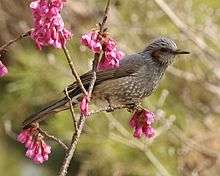Brown-eared bulbul
| Brown-eared bulbul | |
|---|---|
 | |
| Scientific classification | |
| Kingdom: | Animalia |
| Phylum: | Chordata |
| Class: | Aves |
| Order: | Passeriformes |
| Family: | Pycnonotidae |
| Genus: | Hypsipetes |
| Species: | H. amaurotis |
| Binomial name | |
| Hypsipetes amaurotis (Temminck, 1830) | |
| Synonyms | |
|
Microscelis amaurotis
[2] Species: | |
The brown-eared bulbul (Hypsipetes amaurotis) is a medium-sized bulbul native to eastern Asia. It is extremely common within the northern parts of its range and is a familiar bird throughout Japan, where it is called hiyodori (ヒヨドリ), and Korea, where it is known as jikbakguri (직박구리). In Taiwan, on the other hand, it is rare and limited to Orchid Island.[3]
Description
Reaching a length of about 28 cm (11 in), brown-eared bulbuls are grayish-brown, with brown cheeks (the "brown ears" of the common name) and a long tail. While they prefer forested areas, they readily adapt to urban and rural environments, and their noisy squeaking calls are a familiar sound in most areas of Japan.
Distribution and habitat

The brown-eared bulbul is common in a very large range that includes the Russian Far East (including Sakhalin), northeastern China, the Korean Peninsula, and Japan, south to Taiwan and the Babuyan and Batanes island chains in the north of the Philippines.[1]
Historically, brown-eared bulbuls were migratory birds moving to the southern parts of its range in winter, but they have taken advantage of changes in crops and farming practices in recent decades to overwinter in areas farther north than previously possible. As a result, they are considered agricultural pests in some areas of Japan. Most brown-eared bulbuls still move south in winter, often forming huge flocks during migration.
Behaviour
Feeding
In summer, brown-eared bulbuls primarily feed on insects, while they primarily take fruits and seeds in the fall and winter.[4][5]
Breeding
Around five eggs are laid by females, who then incubate the egg. Brown-eared bulbuls are frequently parasitized by cuckoos, whose chicks will push bulbul eggs and chicks out of the nest.[6]
References
- 1 2 BirdLife International (2012). "Ixos amaurotis". IUCN Red List of Threatened Species. Version 2013.2. International Union for Conservation of Nature. Retrieved 26 November 2013.
- ↑ Gregory (2000)
- ↑ Taiwan. Oriental Bird Club Retrieved August 22, 2016
- ↑ Brazil, Mark Noisy bulbuls change with the seasons March 8, 2016 Japan Times Retrieved August 22, 2016
- ↑ Japan Bird Research Association - Brown-eared Bulbul Retrieved August 22, 2016
- ↑ Hooper, Rowan Brown-eared bulbul May 12, 2005 Japan Times Retrieved August 22, 2016
Further reading
- Gray, G.R. (1840): A list of the genera of birds with an indication of the typical species of each genus compiled from various sources (1st edition): 28. London. Available at Gallica (search for "Gray")
- Gregory, Steven M. (2000): Nomenclature of the Hypsipetes Bulbuls (Pycnonotidae). Forktail 16: 164-166. PDF fulltext
- Moyle, Robert G. & Marks, Ben D. (2006): Phylogenetic relationships of the bulbuls (Aves: Pycnonotidae) based on mitochondrial and nuclear DNA sequence data. Mol. Phylogenet. Evol. 40(3): 687-695. doi:10.1016/j.ympev.2006.04.015 (HTML abstract)
- Oliveros, C. H., and R.G. Moyle. 2010. Origin and diversification of Philippine bulbuls. Molecular Phylogenetics and Evolution 54: 822–832.
External links
![]() Media related to Microscelis amaurotis at Wikimedia Commons
Media related to Microscelis amaurotis at Wikimedia Commons
- Brown-eared bulbul at Avibase
- Damage to Crops by Birds study at Okinawa University
